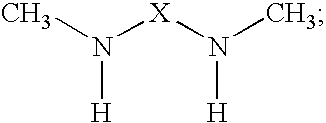Epoxy resin amine curing agent of N,N′-dimethyl secondary diamine polymer
a technology of diamine polymer and diamine curing agent, which is applied in the field of amine and amineepoxy compositions, can solve the problems of stress crack failure of coating, increase the difficulty of forming, so as to improve the “walk-on” dry time, improve the gloss and surface appearance, and improve the effect of hardness developmen
- Summary
- Abstract
- Description
- Claims
- Application Information
AI Technical Summary
Benefits of technology
Problems solved by technology
Method used
Image
Examples
example 1
Synthesis of methylamine-terminated poly-(N-methylazacycloheptane).
[0157]135 g of adipodinitrile, 50 g of isopropanol, and 2.7 g of Pd / Al2O3 catalyst were placed in a 1-liter stainless-steel batch pressure reactor equipped with a stirrer and 1-liter hydrogen ballast tank. The Pd / Al2O3 catalyst is commercially available from the Johnson-Mathey Corporation. The reactor was sealed and subsequently purged with nitrogen and hydrogen to remove any air from the reactor. While stirring the reactor contents, 85 g of anhydrous methylamine were added to the reactor. The reactor was then pressurized with hydrogen to 1.72 MPa (250 psi), and heated to 120° C. These conditions were maintained until the rate of hydrogen uptake from the ballast tank fell below 0.0034 MPa / min (0.5 psi / min). When this occurred, the reactor pressure was raised to 5.86 MPa (850 psi). These conditions were maintained until the rate of hydrogen uptake from the ballast tank fell below 0.0034 MPa / min (0.5 psi / min). The reac...
example 2
Synthesis of methylamine-terminated poly-(N-methylazetidine).
[0161]282 g of acrylonitrile and 8.5 g of water were placed in a 1-liter stainless-steel batch pressure reactor equipped with a stirrer. The reactor was sealed and subsequently purged with nitrogen to remove any air from the reactor. While stirring the reactor contents, 200 g of methylamine were added to the reactor over a time period of 5 hours. During the addition of the methylamine, the reactor temperature was maintained in range of 55-60° C. This temperature range was then maintained for 1.5 hours after the methylamine addition was complete. The reactor was cooled and the intermediate product removed.
[0162]120 g of isopropanol and 7.5 g of Pd / Al2O3 catalyst were placed in a 1-liter stainless-steel batch pressure reactor equipped with a stirrer and 1-liter hydrogen ballast tank. The Pd / Al2O3 catalyst is commercially available from the Johnson-Mathey Corporation. The reactor was sealed and subsequently purged with nitrog...
example 3
Synthesis of methylamine-terminated poly-(N-methylazetidine).
[0166]282 g of acrylonitrile and 8.5 g of water were placed in a 1-liter stainless-steel batch pressure reactor equipped with a stirrer. The reactor was sealed and subsequently purged with nitrogen to remove any air from the reactor. While stirring the reactor contents, 87 g of methylamine were added to the reactor over a time period of 5 hours. During the addition of the methylamine, the reactor temperature was maintained in range of 55-60° C. This temperature range was then maintained for 1.5 hours after the methylamine addition was complete. The reactor was cooled and the intermediate product removed.
[0167]120 g of isopropanol and 7 g of Pd / Al2O3 catalyst were placed in a 1-liter stainless-steel batch pressure reactor equipped with a stirrer and 1-liter hydrogen ballast tank. The Pd / Al2O3 catalyst is commercially available from the Johnson-Mathey Corporation. The reactor was sealed and subsequently purged with nitrogen ...
PUM
| Property | Measurement | Unit |
|---|---|---|
| temperatures | aaaaa | aaaaa |
| temperature | aaaaa | aaaaa |
| pressure | aaaaa | aaaaa |
Abstract
Description
Claims
Application Information
 Login to View More
Login to View More - R&D
- Intellectual Property
- Life Sciences
- Materials
- Tech Scout
- Unparalleled Data Quality
- Higher Quality Content
- 60% Fewer Hallucinations
Browse by: Latest US Patents, China's latest patents, Technical Efficacy Thesaurus, Application Domain, Technology Topic, Popular Technical Reports.
© 2025 PatSnap. All rights reserved.Legal|Privacy policy|Modern Slavery Act Transparency Statement|Sitemap|About US| Contact US: help@patsnap.com



